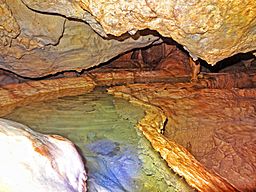Pete's Paradise Cave facts for kids
Quick facts for kids Pete's Paradise Cave |
|
|---|---|
 |
|
| Location | below Queen's Road, Gibraltar |
| Entrances | 1 |
| Features | 4 chambers |
Pete's Paradise Cave is an amazing cave located in Gibraltar, a British territory. It was explored in the 1960s and 1970s by a team led by George Palao. During these explorations, four ancient human skeletons were discovered inside the cave. Two of these were female skeletons, found with signs of injury to their skulls.
Contents
Exploring Pete's Paradise Cave
This special cave is found about sixteen meters below Queens Road. The entrance is one meter tall and six meters wide. When you first enter, the floor is made of earth. This first area was named Nun's Chamber.
Inside the Cave's Chambers
The next part of the cave is called Rimstone Chamber. It gets its name from the cool rimstone pools. These pools are like natural staircases of water, flowing down at different levels.
From here, you can crawl through a tight, eight-meter-long tunnel. This leads you to Pearl's Chamber. This chamber was named for the Cave pearls found there. These pearls form around tiny grains of sand. Over time, layers of calcium carbonate build up around them. They can grow to be about three centimeters wide. For these pearls to form, moving water is needed to keep them turning.
The last chamber is known as the Hall of Pillars. Many people say this is the most beautiful part of the cave. It has another perfect rimstone formation. This is one of only three such formations in Pete's Paradise Cave. It is also one of only three found in all of Gibraltar!
Discovery and Ancient Finds
Pete's Paradise Cave is truly unique. It has clear rimstone pools and a network of tunnels and chambers. The Gibraltar Cave Research Group discovered this cave on February 26, 1966. Members of the group found it while exploring the rock face.
How the Cave Got its Name
The cave was named after Peter Mann, a member of the Research Group. Some people say he named it himself! They believe his first words upon entering the cave were, "This is paradise!"
Studying the Cave's Past
After its discovery, the Gibraltar Cave Research Group carefully mapped the cave. They also started digging to learn more. In 1966, they found many ancient items. These included pieces of Neolithic pottery, bones, and stone tools.
Bones were found throughout the cave at different levels. Most of these bones were from rabbits, apes, and oxen. Many rodent bones were also present. They also found tools made of chert, which is a type of stone, used for engraving. An engraved bone bead, possibly part of a necklace, was also discovered. It might have been engraved with one of the stone tools.
Human Remains in the Cave
During the digging in 1966, human remains were also found. George Palao made this important discovery. Four human skeletons were found, likely from the Neolithic period. These included two female skeletons and two male skeletons. Sadly, there are no official records of this important discovery at the Gibraltar Museum.
Protecting Our Caves
Pete's Paradise Cave shows us why it is so important to protect these natural wonders. This cave was only found in 1966. Yet, studies have already shown that some damage has occurred. Many of the stalactites have been broken. Also, the beautiful pools have been disturbed.
Understanding Cave Palettes
This cave has three perfect "palettes." This is a special natural event. It happens when calcium carbonate floats on very still water. Over thousands of years, it forms a stone rim that seems to float on the water's surface. The final shape can look just like a painter's palette. Protecting these delicate formations is very important for future generations.

